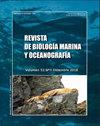Screening for WSSV in crustacean from marine areas of Buenos Aires, Argentina
IF 0.5
4区 生物学
Q4 MARINE & FRESHWATER BIOLOGY
引用次数: 3
Abstract
In total 374 specimens corresponding to four species of shrimp: Artemesia longinaris, Pleoticus muelleri, Peisos petrunkevitchii, Palaemon macrodactylus, and two species of crabs: Neohelice granulata and Cyrtograpsus angulatus were studied in the search of white spot syndrome virus (WSSV). The crustaceans were collected in the estuary of Bahia Blanca, the port of Mar del Plata and the Samborombon Bay, Argentina, between 2010 and 2014. A polymerase chain reaction (PCR) analysis in all of them has not detected any virus presence. These new results suggest that the discovery of infected shrimp in 2008-09 in the Bahia Blanca estuary may have been a one-time local event, promoted by special conditions of seawater temperature inside the estuary, coincident with the presence of a virus carrier or transporter. To determine if the virus was finally installed in the estuary of Bahia Blanca more screening are needed coming from a larger number of shrimp samples. These studies will be necessary mainly in A. longinaris (Penaeidae) since this family of shrimps is most susceptible to be affected by WSSV.阿根廷布宜诺斯艾利斯海域甲壳类动物WSSV筛查
为寻找白斑综合征病毒(WSSV),对4种对虾(Artemesia longinaris)、Pleoticus muelleri、Peisos petrunkevitchii、Palaemon macrodactylus)和2种蟹(Neohelice granulata和Cyrtograpsus angulatus)共374份标本进行了研究。这些甲壳类动物是在2010年至2014年期间在阿根廷的巴伊亚布兰卡河口、马德普拉塔港和Samborombon湾收集的。聚合酶链反应(PCR)分析均未检测到任何病毒存在。这些新的结果表明,2008- 2009年在巴伊亚布兰卡河口发现的受感染虾可能是一次局部事件,是由河口内海水温度的特殊条件引起的,与病毒携带者或转运体的存在相一致。为了确定该病毒是否最终安装在巴伊亚布兰卡河口,需要从更多的虾样本中进行更多的筛选。这些研究将主要在对虾科(Penaeidae)中进行,因为该科对虾最容易受到WSSV的影响。
本文章由计算机程序翻译,如有差异,请以英文原文为准。
求助全文
约1分钟内获得全文
求助全文
来源期刊
CiteScore
0.70
自引率
0.00%
发文量
41
审稿时长
12 months
期刊介绍:
Publicar desde una perspectiva científica, artículos originales, decididos por un proceso de revisión por pares, invitando a expertos de reconocido prestigio en el área. Los trabajos publicados se caracterizarán por su solidez teórica-metodológica, actualidad y relevancia para las ciencias marinas.
Se reciben trabajos inéditos derivados de la investigación científica realizada en ambientes marinos y estuarios, en formato de Revisión, Artículos, Notas Científicas, y Obituarios en las siguientes disciplinas::
Biología-Ecología marina
Oceanografía física, química y biológica
Contaminación marina
Geología marina
Sistemática, Faunística y Biogeografía Marina
Manejo Costero
Acuicultura marina
Pesquería marina.

 求助内容:
求助内容: 应助结果提醒方式:
应助结果提醒方式:


